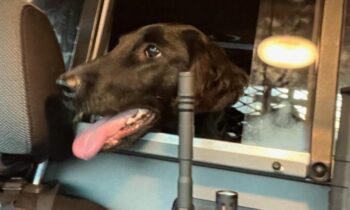


I’ve been writing this weekly blog for about six years now. I’m not going to say anything today that I haven’t said before, here and in person if you’ve ever met me. I’m going to say those things again, because some of you still have not heard me. I will attempt to keep it short and sweet.
I worry every time I find out a friend or neighbor has not heeded these suggestions.
Secure your dog for safety in any vehicle.
I am concerned any time I see an unsecured animal riding in a vehicle. This time of year, that’s happening not only in cars and trucks, it’s happening on motorcycles and boats! In a motor vehicle on land, you are doing your dog and yourself no favor by letting the dog ride loose. In fact, you are risking the dog’s life and maybe even your own. Why would you choose to take that risk?
Convenience.
You make the choice to risk your dog’s life because it is more convenient for you than any safer option. You’ve never had a problem with the dog’s riding loose, you say? Yet, I say.
You’ve been lucky.
Do you wear a seat belt?
Do your dog the courtesy of giving him that—at least.
Did you try a crate but he didn’t want to get in it easily?
Did you give up on that?
Don’t want to “mess up” your ride with crates or gates?
You’re just going to wait until something bad happens.
Your dog is a living being for whom you are completely and totally responsible. Please, I beg you: consider his safety and yours when you transport him in a vehicle, even just a few blocks. Don’t wait for something bad to happen. Secure your dog now in the safest possible way that you can afford.


Photo by Val Hughes
Never take the leash off in an unenclosed area.
You can never trust your dog.
It’s true: you simply cannot guarantee that your dog will always respond appropriately (that is, safely, wisely, and correctly under the circumstances) in every situation.
No matter how much training the dog has had, remove your leash only in a fully enclosed, escape-proof (over, under, around, or through) area that you are absolutely sure is safe.
Allowing your dog to be off-leash otherwise is never safe.
Violating local leash laws makes you liable to legal jeopardy, too, if there are complaints about your dog, whether he’s chasing a cat or frightening the neighbors’ children. Repeat offenses can have serious consequences when the local animal control agency becomes involved.
Don’t make your dog a criminal.
No retractable (flexible) leashes. Use a long line.
Flexible retractable leashes are not safe—period.
You’ve got a friend or neighbor who says, “I’ve never had a problem with my flexi!” I never had a problem with my flexi either, and I agree it can be “convenient,” but I have heard so many stories about what happens when the retractable leash, for the first time, fails or malfunctions, or when it is mishandled, and somebody gets hurt—very badly hurt. Google: “retractable/flexible leash injuries.”
Gross and scary.
Use a long line. They take practice.
Practice. Get better at it and use it.
Know what can go wrong with a dog like yours.
Physically wrong, for starters. For example: is your dog a breed or mix or size that might be susceptible to bloat or torsion? You don’t know? Ask your veterinarian! What are the symptoms? Can it be prevented? What do I do if I suspect my dog is bloating? (Short answer: get to a vet STAT.)
Not all chronic conditions in dogs are life-threatening, of course, but even minor physical issues that don’t kill dogs can be extremely uncomfortable for the dogs as well as worry-inducing and expensive for their owners. For example: ear infections, hot spots, allergies.
Ask your veterinarian on your first visit with a new dog or puppy: what should I keep an eye on? What might happen as my puppy grows up, as my dog ages? What signs and symptoms should I watch for, what should I do when I see those indications? What would constitute an emergency, what can wait for a regular appointment? What can I do to prevent any of these issues in my dog?
Research pet health insurance and choose.
Maybe your dog is older and not in good health. You may find out that insurance for an animal with many pre-existing conditions would not be a practical investment. Consider instead starting a pet health savings account, where you put away a certain amount of money every month for pet health emergencies.
If you’ve just acquired a healthy puppy with no pre-existing conditions, however, don’t blow your chance to start covering your new family member today. Do your research and choose your policy before you bring that puppy home! Chances are, you’ll be very glad you made the choice.
Learn how to do your dog’s basic grooming.
Do you customarily take your dog to a professional groomer every month? Did you end up with a very unkempt-looking dog within the first few weeks of the stay-at-home? Did you hear yourself saying, “Our dog won’t let us . . . ” do whatever minor grooming task she needed to have done, for hygiene and safety, because you found your dog to be totally uncooperative or even frightened by your efforts?
That’s not okay.
You can’t clip your dog’s nails or trim the fur on her feet or around her eyes?
You can learn!
Pay your professional groomer or veterinary technician for their time to teach you how to do the simple weekly grooming procedures your dog requires. Pay a professional positive trainer to help you plan how to change your dog’s mind about you doing this care. If the groomer or the vet tech can trim your dog’s nails easily and without objection from the dog, you know it can be done.
Your job now is to learn how to do it yourself.
I hope that all reading today’s article will consider what I have written.
I applaud all of you who’ve already followed the suggestions I’ve made.
When we know better, we do better, as Maya Angelou wisely once said.
We can all do better.



